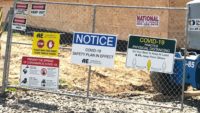With worker pay and benefits under pressure—according to one analysis, the average earnings of a construction worker relative to other occupations has slipped significantly since 1990—it's understandable that the building trades unions would drive a hard bargain before giving their blessing to an immigration reform bill. The process is far from over, but Senate Democrats almost certainly consulted this important constituency while drafting the version of the immigration reform bill the Senate adopted. The House of Representatives is writing its own version.
Over the years, during which the average construction worker's paycheck has been losing its buying power, Hispanic immigrants poured into the U.S. Today, according to federal statistics that include homebuilding, more than one out of three U.S. masons and more than half of all concrete and drywall workers now identify themselves as Hispanic. As of 2010, about 40% of these workers said they had entered the U.S. in the previous 10 years. How many of these workers entered the country illegally? No one can say, but illegal workers are known to be the lowest paid and most exploited. Immigration reform could help change the dynamics of the marketplace and help push wages higher for these and many other workers, especially if business improves.
On its face, the annual cap of 15,000 annual guest-worker visas in construction in the Senate version is an absurdly small proportion of the total construction workforce, which is about six million. Another provision of the Senate version prohibits the use of the guest construction workers if that particular trade is experiencing unemployment higher than 8.5% in a specific metropolitan area. No other industry has such limits, but industry employers, including the Associated General Contractors, believe the cap is much too low. We believe it can increase by at least another 50% with little harm to domestic construction workers. Employers need not be overly concerned, either, because there are more than a million unemployed construction workers on the sidelines.
Here's why pay level is important: Despite numerous reports of worker shortages since late 2011, the average laborer on a buildings project takes home $654 a week; a buildings sheet-metal worker takes home $858. Operating engineers do better, but those wages won't attract much new talent, even if they pay more than a cashier earns at Target.
This is a good time to risk the labor shortages that may force wages up, especially if higher pay brings in better workers. What can't wait is immigration reform, with the main goal of setting up a system that will propel many of the 11 million illegal immigrants toward becoming legal residents and toward citizenship. Most of these people have worked long and hard. They deserve a chance at citizenship.

